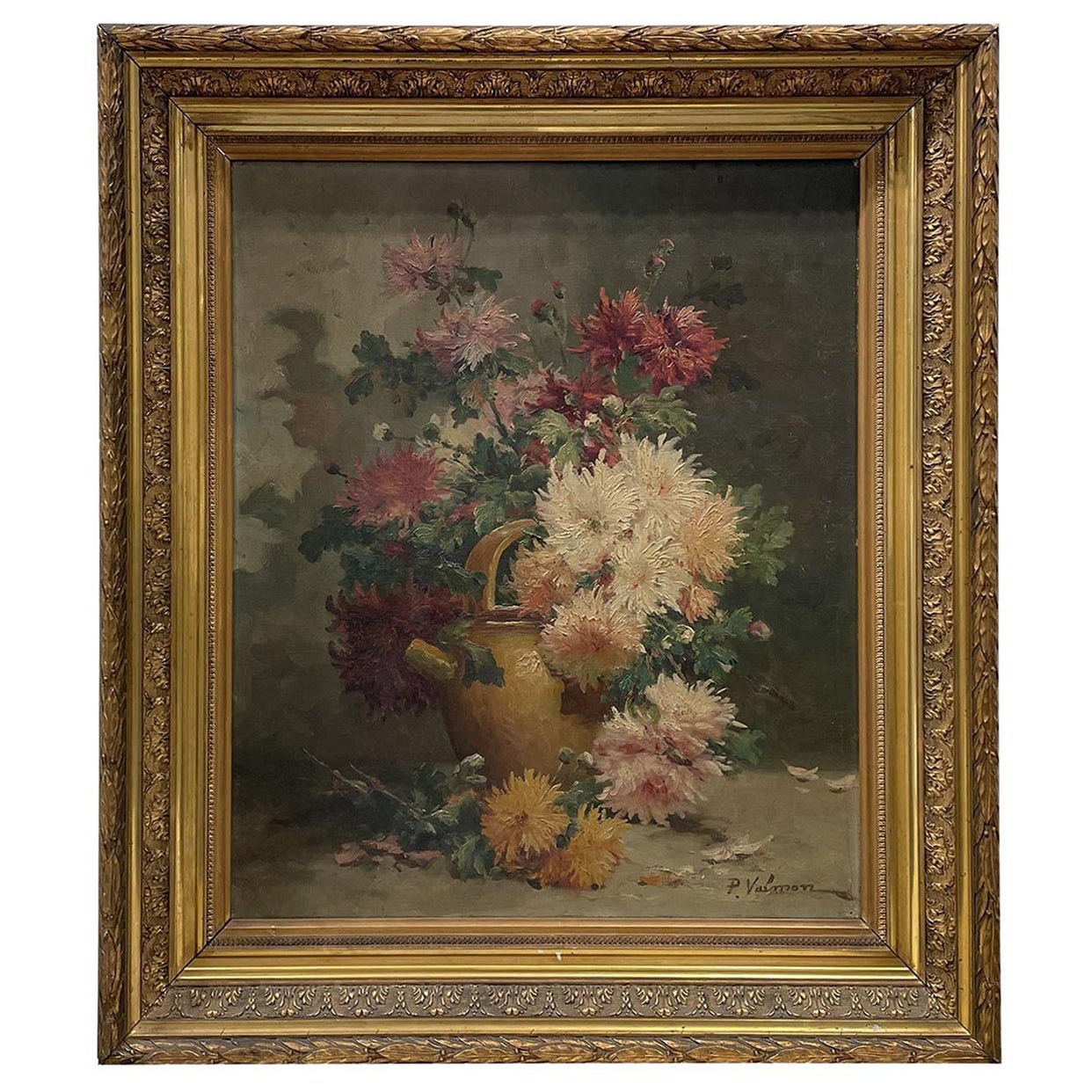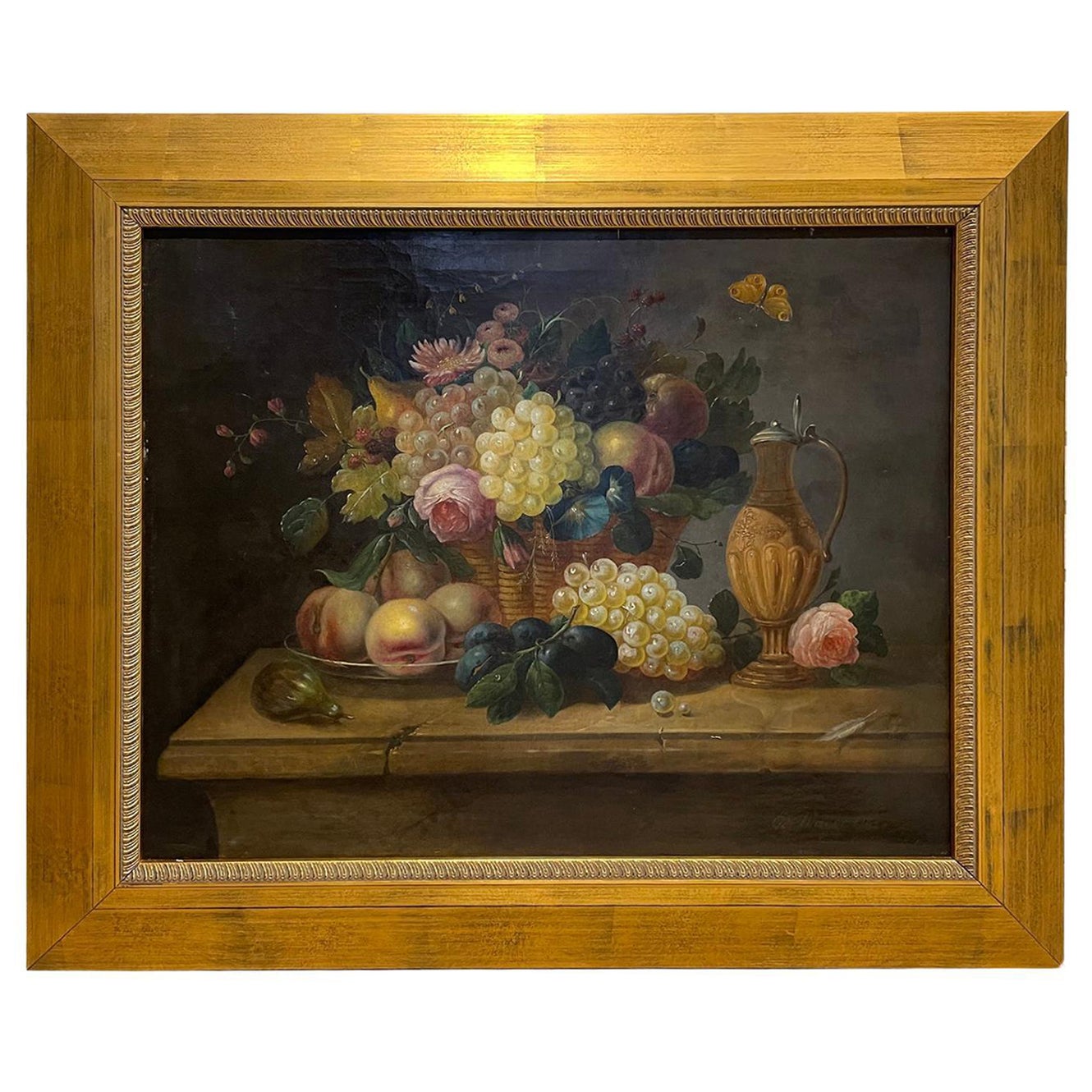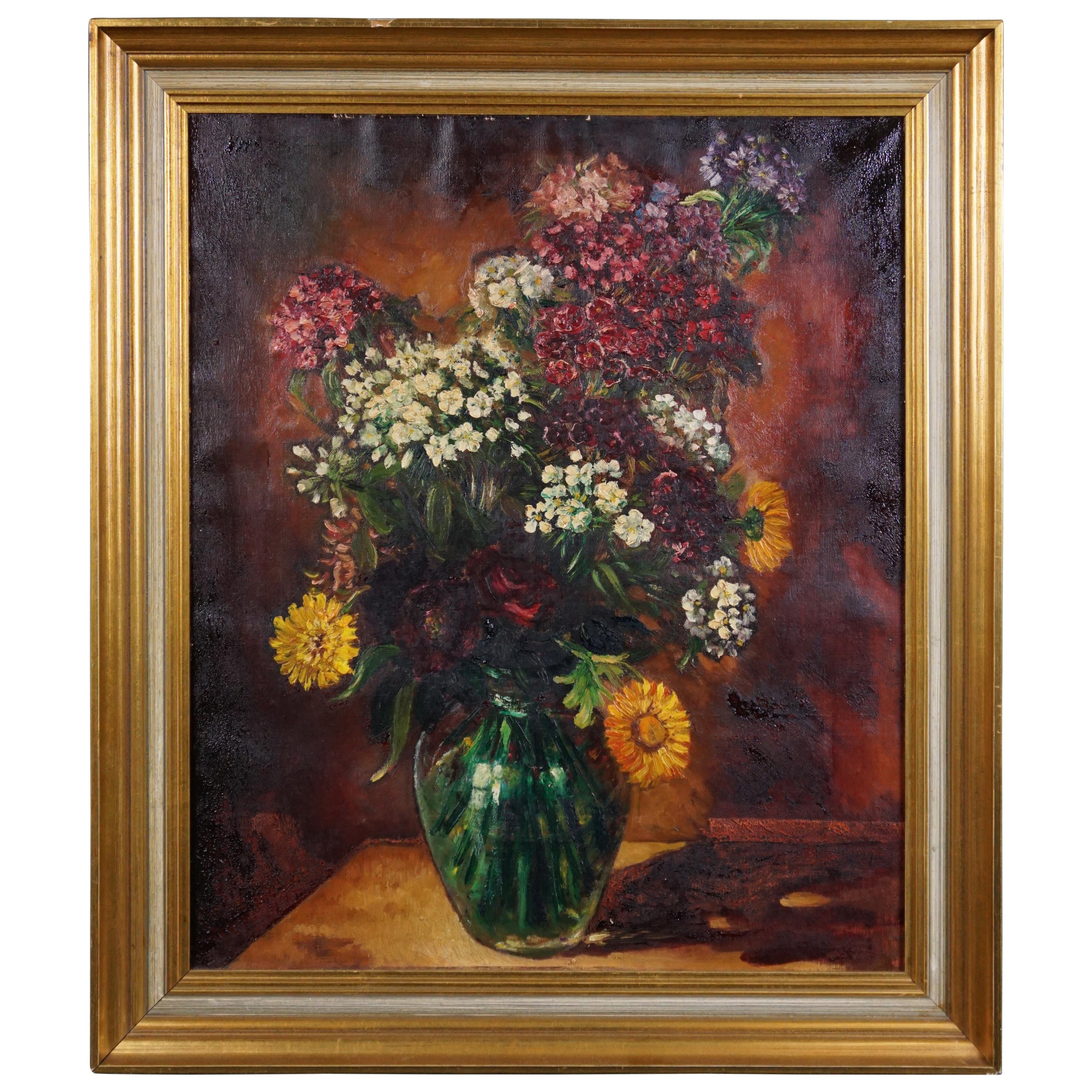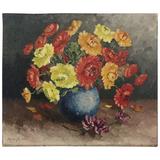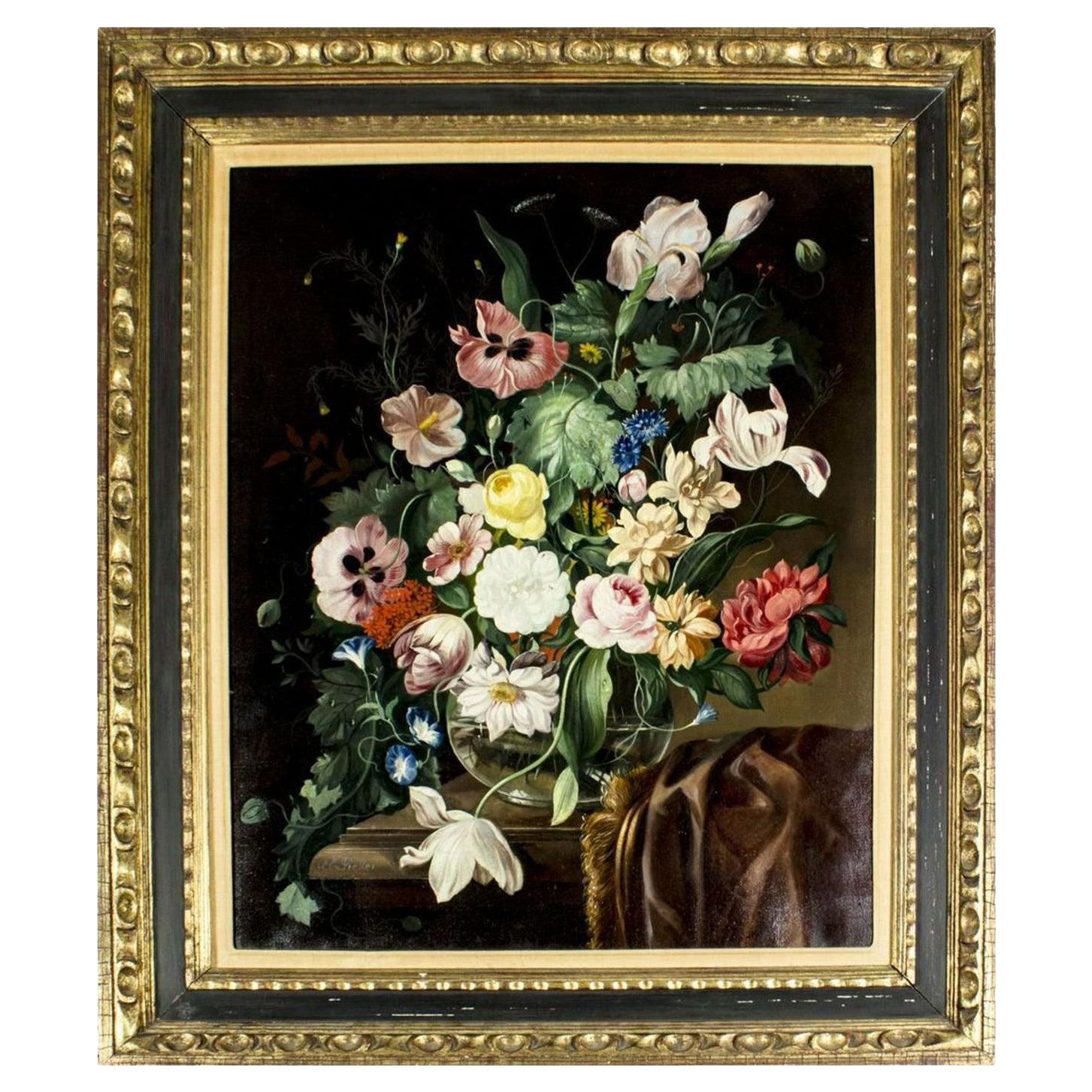Items Similar to 50s Eugene Biel-Bienne Still Life with Flowers Painting Austrian
Video Loading
Want more images or videos?
Request additional images or videos from the seller
1 of 22
50s Eugene Biel-Bienne Still Life with Flowers Painting Austrian
About the Item
One of a kind large-scale still life with flowers, the work of Eugene Biel-Bienne (1902-1969), a standard bearer of the Viennese school of expressionism, one of the most outstanding aspects of this artistic current. He was close to artists like Gustav Klimt or Egon Schiele.
His life is essential to understand his work. He studied at the Academy of Fine Arts at the University of Vienna and completed a PhD in Art History at the University of Cologne. Vienna, awash with intellectual fervor, was fast becoming an unrivaled center of cultural activity. Freud, Mahler, Klimt, Loos, Meis van der Rohe, Hoffman, Herzl, Schoenberg and others were creating new schools of thought in fields such as psychoanalysis, linguistic philosophy, music, art...
Actually, he began his career as a painter in Paris, where he was associated with the School of Paris in the 1930s and became interested in Sigmund Freud's theories of psychoanalysis. Only six years later he held his first solo exhibition. Furthermore, during his time in Paris, Biel became interested in the work of Kandinksy and began to experiment on his own lines of abstract movement (which he insisted on during his stay in the US).
During his adolescence he suffered the consequences of the terrifying disaster of the First World War, and served in the French army during the Second. This war touched him especially closely, since he lost his two children and his wife was disabled when the car in which he was riding was machine-gunned. They had to be evacuated from France, and they marched on New York. Later, he also spent a few years in Caracas (Venezuela). He continued to paint for most of his life, and his painting was exhibited in galleries and museums around the world.
These tragic events conditioned his work, full of suggestive drawings that portray the darkness and pessimism that lived inside him. This work is dated 1952, ten years after arriving in the US. It represents two vases with flowers that stand out for their saturated and contrasting colors on a dark background. It is a painting of fast and loose brushstrokes, very impasto and material, letting itself be carried away by the expression of the feelings and sensitivity of the artist, the maxim of the movement to which it is attached. Each brushstroke is expressive in itself. It is a very personal work, which demonstrates his tormented spirit.
Still lifes or still lifes have their origin in Antiquity, although it was not until the 17th century when they achieved great success. From then on, many artists (Cézzane, Picasso) used the still life genre for their absolutely modern artistic experimentation, or because they were attracted by the symbology it contains. These works allude to the transitory nature of human existence. The flowers, which wither, are a clear symbol of the transience of life.
It is curious that there are two vases with flowers that appear. Could this work be a memory of his two sons lost in the war?
In short, Eugene Biel was one of the most promising expressionist authors in Europe, but his memory and his work have been largely unknown, despite the fact that his work has been exhibited in renowned museums such as the National Gallery in Berlin, the Victoria and The Albert Museum in London, the Museum of Contemporary Art in Madrid, the Belvedere in Vienna, the Musée 'Nationale D'Art Moderne in Paris...
About Expressionism
Expressionism was an avant-garde movement that emerged in Germany at the beginning of the 20th century. From its beginnings, it was deeply marked by the tormented and convulsive climate of the time in which it emerged, and the desire for the false and ancient values that the artists wanted to bury. Although it affected all the arts, it stood out especially in painting and in the cinema. It is based on a distortion of reality to express it in a more subjective way, showing feelings and emotions, under a pessimistic filter.
It was, therefore, a way of understanding art and an attitude towards it and life that arose as a reaction to naturalism, impressionism and its positivist nature at the end of the century. Technical advances, especially in the field of art, the appearance of photography and cinema, led the artist to consider the function of his work, which no longer consisted of imitating reality, since the new techniques did so more objective.
"Expressionists", in the literal sense of the word, in terms of deformers of reality, can be found from much earlier (El Greco, Goya, Van Gogh...); However, the expressionist movement is defined in the pre-war atmosphere of Germany when various artists came together in search of a more personal art, in which the inner vision of the artist (expression) prevailed over the embodiment of reality (impression)
Although it was a very broad movement, the first group that proclaimed this tendency arose around 1905 in Dresden, and was called El Puente (Die Brücke), led by Kirchner. The name refers to the idea of crossing, coming together between two opposite shores, a world that is left behind and another that one tries to reach. It was an art of condemnation and the condemned, which chose the revolt because it hated and rejected the inherited world. At that time, the war only confirmed the omens of crisis.
This environment was the one that conditioned the beginning and development of the expressionist movement. The theme chosen by the artists used to be dark and sordid, always dealing with themes such as loneliness, misery, death, anguish... through loose and expressive brushstrokes of violent colors and with a clear rejection of mimesis, all as a reflection of the existentialist bitterness and the tragic vision of the human being and of life.
In Austria, the expressionists received German influence, although Austrian expressionism stood out for the tension of its compositions. The young Austrian artists followed in the footsteps of Klimt in search of greater expressiveness, with works with existential themes and a philosophical and psychological background (life, death, illness, love, pain...).
igned in the lower left corner. On the back it also presents the author's signature, along with the year.
Dimensions: 114.5 x 153.5 cm.
- Creator:Eugene Biel-Bienne (Artist)
- Dimensions:Height: 45.28 in (115 cm)Width: 60.63 in (154 cm)Depth: 0.79 in (2 cm)
- Style:Expressionist (Of the Period)
- Materials and Techniques:
- Place of Origin:
- Period:
- Date of Manufacture:1952
- Condition:Wear consistent with age and use.
- Seller Location:Valladolid, ES
- Reference Number:1stDibs: LU2943334707682
About the Seller
4.7
Gold Seller
These expertly vetted sellers are highly rated and consistently exceed customer expectations.
Established in 1990
1stDibs seller since 2017
125 sales on 1stDibs
Typical response time: <1 hour
- ShippingRetrieving quote...Ships From: VALLADOLID, Spain
- Return PolicyA return for this item may be initiated within 7 days of delivery.
More From This SellerView All
- French 70s Painting Abnstracción by Serge Arnoux Contemporary PaintingBy French House & GardenLocated in Valladolid, ESExceptional oil on canvas by the French painter Serge Arnoux (1933-2014). This absolutely modern work is characterized by the intense blue color of the background, against which a co...Category
Vintage 1970s French Expressionist Paintings
MaterialsCanvas, Paint
- 20thcentury French Painting, Oil on Canvas, "The Elephant"By French House & GardenLocated in Valladolid, ESImposing canvas of a representation of one of the most important pachyderm, the elephant. It is a work of the French School and belongs to abstract expressionism, with a great tex...Category
Vintage 1980s French Expressionist Paintings
MaterialsCanvas, Paint
- Belgian expressionist painting “Teaching to read”, Gustave Camus, 43 signedBy François Camus, ParisLocated in Valladolid, ESOne of a king , Exquisite and very important work of art !!!! Oil on canvas by Belgian painter Gustave Camus, signed and dated in the lower right corner. The work introduces us as sp...Category
Vintage 1940s French Expressionist Paintings
MaterialsCanvas, Wood, Paint
- Antonio Murado Green Oil on Canvas, expressionist, blue , green PaintingBy Spanish ManufactoryLocated in Valladolid, ESSigned in Madrid in 1993, this work by Antonio José Murado synthesizes the aspects of expressionist figuration, a current to which the artist was closely related, specifically during...Category
1990s Spanish Expressionist Paintings
MaterialsCanvas, Paint
- 18th Century Spanish Painting on the Glass, Couple of Painting, Gildwood FrameLocated in Valladolid, ESAmazing pair of baroque cornucopias, with painted glass, s. XVIII, Spanish origin, Andalusian school (Córdoba) Outstanding pair of Cornucopias in carved wood and gilwood decorated w...Category
Antique 1780s Baroque Paintings
MaterialsGlass, Giltwood, Paint
- Belgian Painting Allegoric signed by P. SwyncopBy Philip SwyncopLocated in Valladolid, ESÓ/L “Peace and the arts are worth more than the brutal glory of weapons”, Philippe Swyncop, 1903 – Belgium, Flemish School Exquisite oil on canvas signed and dated by Belgian artist...Category
Antique Early 1900s Belgian Art Nouveau Paintings
MaterialsPaint, Canvas
You May Also Like
- 19th Century Austrian Still Life Oil Painting with Flowers by Eduard WugerBy Eduard WugerLocated in West Palm Beach, FLA light-grey, black oil on canvas painting with flowers and fruits, painted by Eduard Wuger in good condition. The colorful antique Austrian painting depicts a round braided basket with many fruits, standing on a wooden working table...Category
Mid-20th Century Austrian Decorative Art
MaterialsCanvas
- Oil painting with a still life of a vase with flowers.Located in Harderwijk, NLOffered is this floral beauty captured in oil paint in warm colors. Transform your space into an oasis of natural beauty and sophistication with this breathtaking oil painting of a g...Category
Vintage 1960s Dutch Paintings
MaterialsCanvas, Wood, Paint
- Still Life Vase with FlowersLocated in Vienna, ATOil on canvas, work made in Austria in the 1960s. Signed on the corner by unknown artist.Category
Vintage 1960s Austrian Paintings
- 19th Century French Still Life Oil Painting of Flowers by Eugène Henri CauchoisBy Eugene Henri CauchoisLocated in West Palm Beach, FLA pink-white, antique French still life oil on canvas painting depicting a working table with a yellow teapot vase with flowers, painted by Eugène Henri ...Category
Antique Late 19th Century French Decorative Art
MaterialsCanvas, Giltwood
- 20th Century Austrian Still Life Oil Painting with Flowers by Franz Xaver PielerBy Franz Xaver PielerLocated in West Palm Beach, FLA black-yellow, dark green antique Austrian still life oil on canvas painting depicting a clear glass vase with many flowers painted by Franz Xaver Pieler in a hand carved, original gilded wood frame, in good condition. The colorful painting depicts a dining table in a DIM room, representing the 19th...Category
Early 20th Century Austrian Decorative Art
MaterialsCanvas, Wood, Giltwood
- Still Life with Flowers by M. RoblieLocated in Los Angeles, CAContinental school still life from the Late 19th century of flowers with a vase and bird, signed "M. Roblie" lower right. Dimensions: Sight: 30" H x 20" W; Frame: 38" H x 27" W.Category
Antique 19th Century Paintings
MaterialsCanvas, Wood, Paint
